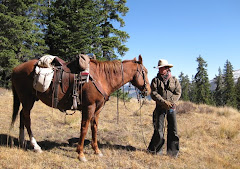 Out on a pack trip, the highline serves as the barn for the night for our horses. The longer we stay at any one given camp, the more the horses learn to find a comfort zone by the highline. Although riding or pastured during the day when at camp, even hobbled horses have been known to hop back up hill and stand in the trees under “their” place in the highline when frightened, for protection from a sudden rain or hail storm, or just to rest when their bellies are full.
Out on a pack trip, the highline serves as the barn for the night for our horses. The longer we stay at any one given camp, the more the horses learn to find a comfort zone by the highline. Although riding or pastured during the day when at camp, even hobbled horses have been known to hop back up hill and stand in the trees under “their” place in the highline when frightened, for protection from a sudden rain or hail storm, or just to rest when their bellies are full.The highline can be as simple as the lash rope when removed from around the pack saddle, stretched between two trees with the cinch used as a handy tree saver; or a specialty rope like we tend to use now which is plenty long, perhaps 70 or 75 feet long, with metal rings to tie to, woven into the rope at about 10 foot intervals for a safe distance between horses.
A simple option is a long 75’ or longer climbing rope that can be packed last – then unpacked first when at camp. Using old cinches or proper tree savers, secure the rope between two large, sturdy trees, a minimum of 10 inch diameter. The rope should hang high; at the lowest point in the center, it should be about as high as you can reach with your arms over your head. I usually have to jump up to catch the rings of the highline when tying up horses at night. My boys are much taller than I am…
Now, here’s a handy trick I read about years ago and have used from time to time throughout the years. Cut short sections of ¼ inch diameter rope (I use climbing or marine rope), each about two feet long. Burn the ends to seal, then tie the ends into a slip proof knot so that you have a loop about 10 inches long. Make several of these – one for each horse. Then when you’re at camp, each of these will be the “ring” onto which you tie the horses’ lead rope to the highline. If you loop these over the highline, then pull the backside through the itself (see the photo above – it’s really so simple) you’ll end up with a slip proof ring onto which you can tie your horse’s lead, and not worry about the lead rope (and the horse) zipping back and forth on the highline all night, and getting too close for comfort to the horse next door.
To tie the lead rope onto these or the metal rings of the highlines, fold over the last 2 feet of lead rope, pass this folded section through the ring on the highline, grab the folded end as it comes halfway through the ring. In the same hand, also grab the end of the lead rope which is hanging loose on the opposite side of the ring from the folded end. With your other hand, turn back a section of the lead rope coming down from the ring and attached to your horse (caution here to keep fingers out the way!) and make a little loop. Drop the folded end and the loose end through this loop. Adjust your slack and tighten from the length of rope leading back down to the horse. There should be enough slack in the line so that the horse’s head is not held up high, but not so much that he or she can take several steps to the side and possibly kick the neighbor.
The photo above has the white marine rope at the top representing the highline. The yellow striped rope shows the simple but secure "rings" attaching to the highline. Then the white marine rope at the bottom shows how the horse’s lead rope is attached to the highline ring.
This is a great knot because it is so quick and easy to tie up, only one of our horses knows how to untie this knot (he can untie most any knot), and no matter how the horse may pull back, it is a breeze to untie by simply pushing up with the section of rope which leads back to the horse, thereby relaxing the loop and allowing the folded end and loose end to slip out. We use this same knot to tie together our pack string – securing one pack horse’s lead rope to the pigging strings on the pack saddle of pack horse in front.





